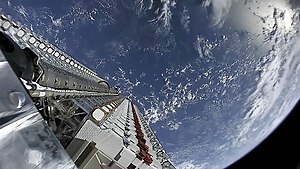With performance that far surpasses that of traditional satellite internet, and a global network unbounded by ground infrastructure limitations, Starlink will deliver high speed broadband internet to locations where access has been unreliable, expensive, or completely unavailable.
Starlink is targeting service in the Northern U.S. and Canada in 2020, rapidly expanding to near global coverage of the populated world by 2021.
Keeping Space Clean
Starlink is on the leading edge of on-orbit debris mitigation, meeting or exceeding all regulatory and industry standards.
At end of life, the satellites will utilize their on-board propulsion system to deorbit over the course of a few months. In the unlikely event the propulsion system becomes inoperable, the satellites will burn up in Earth’s atmosphere within 1-5 years, significantly less than the hundreds or thousands of years required at higher altitudes.
Now let's see what Wikipedia says.
Starlink is a satellite constellation being constructed by SpaceX[2][3] to provide satellite Internet access.[4][5] The constellation will consist of thousands of mass-produced small satellites in low Earth orbit (LEO), working in combination with ground transceivers. SpaceX also plans to sell some of the satellites for military,[6] scientific, or exploratory purposes.[7] The SpaceX satellite development facility in Redmond, Washington houses the Starlink research, development, manufacturing, and on-orbit control operations. The total cost of the decade-long project to design, build, and deploy the constellation was estimated by SpaceX in May 2018 to be about US$10 billion.[8]
 60 Starlink satellites stacked together before deployment on 24 May 2019. | |
| Manufacturer | SpaceX |
|---|---|
| Country of origin | United States |
| Operator | SpaceX |
| Applications | Internet service |
| Website | starlink |
| Specifications | |
| Spacecraft type | Small satellite |
| Launch mass | 227–260 kg (500–573 lb) |
| Equipment | Ku, Ka, and E-band phased array antennas Hall-effect thrusters |
| Regime | Low Earth (335.9–1,325 km (208.7–823.3 mi)) |
| Production | |
| Status | Active |
| Launched | Total: 540[1] Tintin: 2 v 0.9: 60 v 1.0: 478 |
| Maiden launch | 22 February 2018 |
| Last launch | 13 June 2020 |
 | |
Product development began in 2015, with the first two prototype test-flight satellites launched in February 2018. A second set of test satellites and the first large deployment of a piece of the constellation occurred in May 2019 when the first 60 operational satellites were launched.[2][9] As of 2020, SpaceX is launching 60 satellites at a time, aiming to deploy 1,584 of the 260 kilograms (570 lb) spacecraft to provide near-global service by late 2021 or 2022.[10] SpaceX is targeting a private beta service in the Northern United States and Canada by August 2020 with a public beta following in November 2020, service beginning at high latitudes between 44°-52° North.[11][12]
Concerns have been raised about the long-term danger of space debris resulting from placing thousands of satellites in orbits above 600 kilometres (370 mi)[13][14] and a possible impact on astronomy,[15] although the Starlink satellite orbits were lowered to 550 kilometres (340 mi) or below[16] and SpaceX is reportedly attempting to solve the latter issue. On Starlink 2, one of the satellites has an experimental coating to make it less reflective, and thus impact ground-based astronomical observations less.[17] A June 2020 launch included one satellite with an experimental sunshade.[18]
On 15 October 2019, the U.S. Federal Communications Commission submitted filings to the International Telecommunication Union on SpaceX's behalf to arrange spectrum for 30,000 additional Starlink satellites to supplement the 12,000 Starlink satellites already approved by the FCC.[19]
Satellite Constellation




Comments
Post a Comment